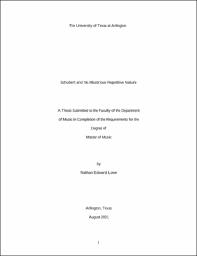
ATTENTION: The works hosted here are being migrated to a new repository that will consolidate resources, improve discoverability, and better show UTA's research impact on the global community. We will update authors as the migration progresses. Please see MavMatrix for more information.
Show simple item record
| dc.contributor.advisor | Hunt, Graham G. | |
| dc.creator | Lowe, Nathan Edward | |
| dc.date.accessioned | 2021-09-14T16:26:41Z | |
| dc.date.available | 2021-09-14T16:26:41Z | |
| dc.date.created | 2021-08 | |
| dc.date.issued | 2021-08-16 | |
| dc.date.submitted | August 2021 | |
| dc.identifier.uri | http://hdl.handle.net/10106/30027 | |
| dc.description.abstract | Schubert’s music is renowned for its repetitive nature; many critics like Dr. Joshua Drake think this is a negative trait of his compositions. When speaking on Schubert’s strengths and weaknesses, Dr. Drake states, “Haydn's rich use of received forms, his clear melodic and tonal dichotomies, and his tendency for certain resolutions make his music satisfying in a completely different way than the wandering, repetitive, self-interrupting Schubert."1 Dr. Drake faults Schubert on his repetitions; in this thesis, several examples of Schubert's instrumental and piano music will give evidence that counters that claim. On the other side of Schubert's repetition, Jonathan Guez proposes the question: "Are they tied up with now-forgotten generic conventions, a composer's whim, an inability to constrain the creative impulse, or an aesthetic aversion to strict thematic repetition?"2 Guez poses the rhetorical question to support Schubert's repetitious nature. One cannot argue that there are cases where Schubert wrote out large sections and small phrases note for note. However, there are several compositions by other famous composers that contain verbatim repeats. The composers of said compositions do not have critics giving negative reviews of their compositions.
By analyzing Schubert's instrumental compositions in various larger forms, one can find an extensive amount of evidence against the stigma some have given his works. The alterations to the repeated sections, themes, and motives varies from small structural changes to two- measure units and larger structural changes that modify the entire piece. Using similar, or the same musical material, Schubert found ways to prolong, deviate, cadence, transition, loosen theme types, the exposition, and recapitulation in sonata forms and subvert expectations of the overall goal of larger forms and the structure of those pieces. Addressing the stigma of harsh critics step-by-step, moving from the most simplistic structural changes to the more significant changes, will provide the reader with the easiest way to follow the evidence. Presenting the structural changes to each musical example will effectively refute the critics' claims. | |
| dc.format.mimetype | application/pdf | |
| dc.language.iso | en_US | |
| dc.subject | Schubert | |
| dc.subject | Music | |
| dc.subject | Music theory | |
| dc.subject | Schenker | |
| dc.subject | Caplin | |
| dc.subject | Guez | |
| dc.subject | Formal-function theory | |
| dc.subject | Piano | |
| dc.subject | Sonata | |
| dc.subject | Repetition | |
| dc.subject | Hepokoski | |
| dc.subject | Darcy | |
| dc.title | SCHUBERT AND HIS ILLUSTRIOUS REPETITIVE NATURE | |
| dc.type | Thesis | |
| dc.degree.department | Music | |
| dc.degree.name | Master of Music | |
| dc.date.updated | 2021-09-14T16:26:42Z | |
| thesis.degree.department | Music | |
| thesis.degree.grantor | The University of Texas at Arlington | |
| thesis.degree.level | Masters | |
| thesis.degree.name | Master of Music | |
| dc.type.material | text | |
| dc.creator.orcid | 0000-0001-8449-0200 | |
Files in this item
- Name:
- LOWE-THESIS-2021.pdf
- Size:
- 2.721Mb
- Format:
- PDF
This item appears in the following Collection(s)
Show simple item record


